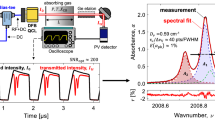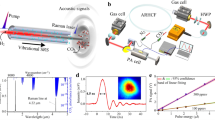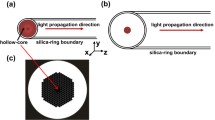Abstract
We have designed and implemented a non-intrusive method for measuring gas viscosity coefficients of gases with accessible absorbing transitions based on transient tunable diode laser absorption spectroscopy (TDLAS) in a 20 µm hollow-core photonic crystal fiber (HC-PCF). As the system contains no moving parts and can be used with a fiber of arbitrary length, it is suitable for viscosity measurements at elevated temperature and under low-density conditions. The gas flow through HC-PCF is driven by a known, constant pressure gradient imposed by gas in two gas cells at either end of the fiber. Infrared radiation from a diode laser is coupled to the fiber to be guided through the gas. A photodetector is placed at the fiber exit to measure the change of light intensity due to absorption from the molecular species. The path-averaged number density of the flow undergoing this transient process can be monitored in real time by TDLAS, based on the Beer–Lambert law, relating absorbance to gas concentration. An existing numerical model describing the time-varying local number density distribution is applied for the numerical determination of viscosity coefficient, by relating the viscosity to the time required for the gas flowing through the fiber to reach a steady state. This measurement method is validated by measuring the viscosity of CO2 as a reference gas at room temperature and inlet pressure ranging from 29 to 3.6 kPa, extending the lower limit of viscosity measurements to pressures below 10 kPa, where laboratory data are lacking. The experimental outcomes are in reasonable agreement with the theoretical value, confirming the effectiveness of this new measurement technique.





















Similar content being viewed by others
References
Abramson EH (2009) Viscosity of carbon dioxide measured to a pressure of 8 GPa and temperature of 673 K. Phys Rev E 80(2):021201
Allen MG (1998) Diode laser absorption sensors for gas-dynamic and combustion flows. Meas Sci Technol 9(4):545
Blanchard D, Ligrani PM (2006) Micro-scale and millimeter-scale rotating disk couette flows, experiments and analysis. Exp Fluids 41(6):893–903
Coleman TF, Li Y (1996) An interior trust region approach for nonlinear minimization subject to bounds. SIAM J Optim 6(2):418–445
Davani E, Falcone G, Teodoriu C, McCain WD Jr (2012) Rolling ball viscometer calibration with gas over whole interest range of pressure and temperature improves accuracy of gas viscosity measurement. Ind Eng Chem Res 51(46):15276–15281
Demtröder W (2013) Laser spectroscopy: basic concepts and instrumentation. Springer Science & Business Media, Berlin
Docter A, Lösch H, Wagner W (1999) A new apparatus for combined measurements of the viscosity and density of fluids for temperatures from 233 to 523 K at pressures up to 30 MPa. Int J Thermophys 20(2):485–505
Estrada-Alexanders AF, Hurly JJ (2008) Kinematic viscosity and speed of sound in gaseous CO, CO2, SiF4, SF6, C4F8, and NH3 from 220 K to 375 K and pressures up to 3.4 MPa. J Chem Thermodyn 40(2):193–202
Gao R-K, Sheehe S, Kurtz J, O’Byrne S (2016) Measurement of gas viscosity using photonic crystal fiber. In: AIP conference proceedings, vol 1786. AIP Publishing, Melville p 080008
Goldenstein C, Schultz I, Jeffries J, Hanson R (2011) Tunable diode laser absorption sensor for measurements of temperature and water concentration in supersonic flows. AIAA Pap 1094:2011
Golubev I, Gnezdilov N, Brodskoya G (1971) The viscosity of air and carbon dioxide at various temperatures and pressures. Kimiya i teknol organ sinteza ONTl, GIAP:part 8:48
Haepp H (1976) Measurements on viscosity of carbon-dioxide and propylene. Thermo Fluid Dyn 9(4):281–290
Hanson RK (2015) Advances in tunable diode laser absorption spectroscopy (TDLAS) for measurements of gas properties in combustion systems. In: Conference on lasers and electro-optics: science and innovations. Optical Society of America, p STh4O. 1
Harvey AH, Huber ML, Laesecke AR, Muzny CD, Perkins RA (2014) Progress toward new reference correlations for the transport properties of carbon dioxide. Paper presented at the Southwest Research Institute: The 4th International Symposium–Supercritical CO2 Power Cycles
Hendl S, Neumann A-K, Vogel E (1993) The viscosity of carbon dioxide and its initial density dependence. High Temp High Press 25(5):503–511
Kestin J, Whitelaw JH (1963) A relative determination of the viscosity of several gases by the oscillating disk method. Physica 29(4):335–356
Krishna Y, Sheehe SL, O’Byrne SB (2015) A time-resolved temperature measurement system for free-piston shock tunnels. In: 31st AIAA Aerodynamic measurement technology and ground testing conference. p 2249
Kurin V, Golubev I (1974) Viscosity of argon, air and carbon-dioxide at pressures up to 4000 Kgf/cm2 and at different temperatures. Therm Eng 21(11):125–127
Lytkine A, Jaeger W, Tulip J (2005) Long-wavelength VCSELs for applications in absorption spectroscopy: tuning rates and modulation performances. In: Proc SPIE, vol 5737, p 157–166
Rankine A (1910) On a method of determining the viscosity of gases, especially those available only in small quantities. Proc R Soc Lond Ser 83(562):265–276
Rothman LS, Gordon IE, Babikov Y et al (2013) The HITRAN2012 molecular spectroscopic database. J Quant Spectrosc Radiat Transfer 130:4–50
Russell P (2003) Photonic crystal fibers. Science 299(5605):358–362
Schäfer M, Richter M, Span R (2015) Measurements of the viscosity of carbon dioxide at temperatures from (253.15 to 473.15) K with pressures up to 1.2 MPa. J Chem Thermodyn 89:7–15
Sharipov F, Graur I (2014) General approach to transient flows of rarefied gases through long capillaries. Vacuum 100:22–25
Sharipov F, Seleznev V (1998) Data on internal rarefied gas flows. J Phys Chem Ref Data 27(3):657–706
Sutherland W (1893) LII. The viscosity of gases and molecular force. Lond Edinb Dublin Philos Mag J Sci 36(223):507–531
Swinehart D (1962) The Beer–Lambert law. J Chem Educ 39(7):333
Teboul V, St-Arnaud J, Bose T, Gelinas I (1995) An optical capillary flow viscometer. Rev Sci Instrum 66(7):3985–3988
Van Der Gulik P (1997) Viscosity of carbon dioxide in the liquid phase. Physica A 238(1):81–112
Vázquez-Cendón E, Hidalgo A, Navarro PG, Cea L (2012) Numerical methods for hyperbolic equations. CRC Press, Boca Raton
Vogel E (2016) The viscosities of dilute Kr, Xe, and CO2 revisited: new experimental reference data at temperatures from 295 K to 690 K. Int J Thermophys 37(6):1–20
Vogel E, Barkow L (1986) Precision-measurement of the viscosity coefficient of carbon-dioxide between room-temperature and 650 K, vol 267. Akademische Verlagsgesellsch Geest & Portig Sternwartenstrasse 8 Postschliesfach 106, Leipzig, p 1038–1043
Yu F, Xu M, Knight JC (2016) Experimental study of low-loss single-mode performance in anti-resonant hollow-core fibers. Opt Express 24(12):12969–12975
Author information
Authors and Affiliations
Corresponding author
Rights and permissions
About this article
Cite this article
Gao, R., O’Byrne, S., Sheehe, S.L. et al. Transient gas viscosity measurement using tunable diode laser absorption spectroscopy. Exp Fluids 58, 156 (2017). https://doi.org/10.1007/s00348-017-2438-3
Received:
Revised:
Accepted:
Published:
DOI: https://doi.org/10.1007/s00348-017-2438-3




